Esta curiosa coincidencia aún no ha sido adecuadamente explicada. La Cultura del valle del Indo se remonta miles de años antes que la cultura de la Isla de Pascua comenzase, sin embargo, la similitud entre las dos secuencias de comandos es extraña…”
Mohenjo Daro: (Indus Valley City).
Mohenjo-Daro was a city located in the south of Modern Pakistan in the Sindh Province, on the right bank of the Indus River. It was built between four and five thousand years ago, and lasted until 3,700 BP. It was part of the Harrapan Civilization, and at its peak, the city had at least 35,000 residents.This was a sophisticated society with a wide-ranging diet that consisted of meat from both wild and domesticated animals and a variety of cultivated wheat, barley, peas and lentils – a huge step forward in human progression from the nomadic hunter-gatherers.Mohenjo Daro was one of the largest centres of the Indus Valley Civilisation, experiencing the transition from Stone-age to Bronze-age.
| Mohenjo Daro: (Mound of the Dead). |
Mohenjo Daro is probably the best known of the Indus Valley civilisation cities. Similar in style and date to Harappa in north Pakistan, it was built almost entirely of kiln-fired bricks between 2,500 and 2,100 BC (12). Originally square in outline, the City was laid out along the lines of a grid. Twelve main streets divided it, of which eleven blocks were residential with the twelfth section being dominated by the Citadel.
The city had a sophisticated sewage system with regular manhole covers. Public latrines for every block and sewers large enough to walk in. (1) House drains, which were enclosed systems, were made of clay pipes and were connected to the sewers by open brick gutters.
Mohenjo-daro was first occupied about 3,500 BC, and it was continuously occupied until between 1700 and 1300 BC. Its Indus occupations lasted between about 2600-1900 BC. (2)
|
The Great Baths:
One of the most spectacular structures at Mohenjo is the 'Great Bath', which is astonishingly well preserved and measures 180 feet north to south and 108 feet east to west. It is described as a “vast hydropathic establishment and the most imposing of all the remains unearthed at Mohenjo-Daro,” by Sir Marshall. (17)
“Its plan is simple: in the centre, an open quadrangle with verandahs on its four sides, and at the back of three of the verandahs various galleries and rooms; on the south, a long gallery with a small chamber in each corner; on the east, a single range of small chambers, including one with a well; on the north a group of several halls and fair-sized room. In the midst of the open quadrangle is a large swimming-bath, some 39 feet long by 23 feet broad and sunk about 8 feet below the paving of the court, with a flight of steps at either end, and at the foot of each a low platform for the convenience of bathers, who might otherwise have found the water too deep. The bath was filled from the well…, and the waste water was carried off through a covered drain…The Great Bath had a least one upper storey as evidenced by a stairway. A large amount of timber, possibly richly carved, must have gone to the building of the upper storey, judging from the quantities of charcoal and ashes found in the course of excavation".
The outer walls of the Great Bath measure between 7 and 8 feet in thickness and were lined with bitumen.

It is possible that this 'Bath' was a common purification pool.
|
More than a thousand settlements are now known from the Indus valley civilisation. The civilisation is known to have had a unity of culture, art, script, and technology (even weights and measures). The largest city, Mohenjo Daro is thought to have reached a population of approximately 30,000, suggesting a total population of approximately 5 million people. (1)
It was the largest of the four ancient civilizations of Egypt, Mesopotamia, India and China. However, of all these civilizations the least is known about the Indus Valley people. This is because the Indus script has not yet been deciphered. There are many remnants of the script on pottery vessels, seals, and amulets, but without a "Rosetta Stone" linguists and archaeologists have been unable to decipher it.
Indus Valley Civilisation (IVS) - It has been surprising to archaeologists that the site layouts and artefacts styles throughout the Indus region are very similar. It has been concluded these indicate that there was uniform economic and social structure within these cities. (6)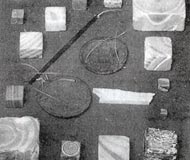
An additional indicators of this is that the bricks used to build at these Indus cities are all uniform in size (7cm x14cm x 28cm). Sun-dried bricks were used for infill, and burnt bricks were used for the drain and sewer linings. It would seem that a standard brick size was developed and used throughout the Indus cities. Besides similar brick size standard weights are seen to have been used throughout the region as well. (7) The weights that have been recovered have shown a remarkable accuracy. They follow a binary decimal system: 1, 2, 4, 8, 16, 32, up to 12,800 units, where one unit weighs approximately 0.85 grams. Some of the weights are so tiny that they could have been used by jewellers to measure precious metals. ( 8)
|
Other Interesting Discoveries at Mohenjo Daro:
Stone ‘seals’ with intricate carving were found (see below), that correspond to similar Iraqi seals from the mid-third millennium BC. (1). Some of the seals found were almost exact the same as those found in ancient Sumerian sites.
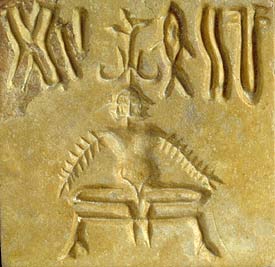

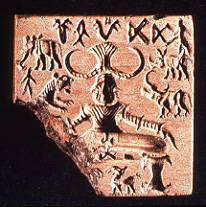

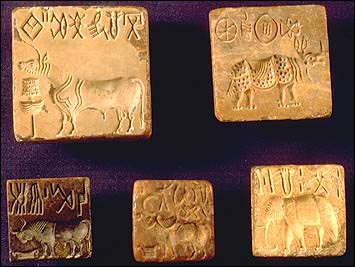
Note: Appearance of Sumerian 'Gilgamesh' figure bottom left.
Ancient Mesopotamian texts speak of trading with at least two seafaring civilizations - Makkan and Meluha - in the neighbourhood of India in the third millennium B.C. This trade was conducted with real financial sophistication in amounts that could involve tons of copper. The Mesopotamians speak of Meluha as an aquatic culture, where water and bathing played a central role. A number of Indus Valley objects have been found buried with Mesopotamians.
The ancient script of the Indus valley people has been found in another location, Easter Island; which is exactly diametrically opposed to Mohenjo daro. This curious coincidence has yet to be properly explained. The Indus Valley Culture was extant thousands of years before the Easter Island culture began, yet the similarity between the two scripts is uncanny.
Article: Computers unlock secrets of Indus-Valley script. (Science Daily: 2009)
|
The Dancing Girl. (Bronze Figurine): 2,500 BC. Mohenjo Daro.
The famous "Dancing girl" found in Mohenjo-daro is an artifact that is some 4,500 years old. The 10.8 cm long bronze statue of the dancing girl was found in 1926 from a house in Mohenjo-daro.

Dancing girl, Mohenjo Daro (Left), Potsherd, Haryana (Right)
Article: The Hindu. Wednesday, Sep 12, 2007:
In a rare discovery, the Archaeological Survey of India has found at Bhirrana, another Harappan site in Fatehabad district in Haryana, a red potsherd with an engraving that resembles the ‘Dancing Girl,’ the iconic bronze figurine of Mohenjo daro. While the bronze was discovered in the early 1920s, the potsherd with the engraving was discovered during excavations by the ASI in 2004-05.
(Link to Full Article: http://www.hindu.com/2007/09/12/stories/2007091255372200.htm )
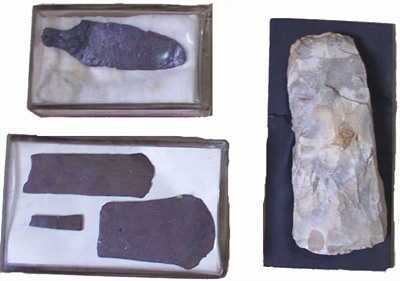
Tools.
Several Copper and Bronze objects have been discovered at Mohenjo Daro, they were first cast and then hammered to required shape. Stone axes and flake-knives have also been found in several houses of Mohenjo-Daro illustrating that the city witnessed the transition from 'stone-age' to 'Bronze-age'.
 The 'priest-king' - The statue of the so called priest-king has a circular space on the forehead. A small gold disc, unearthed in the same location fits perfectly into this space and is suggestive of a possible forerunner to the 'Third-eye' or 'Bindi' of Hindu myth. Shiva had a third eye called the 'burning eye'.
The 'priest-king' - The statue of the so called priest-king has a circular space on the forehead. A small gold disc, unearthed in the same location fits perfectly into this space and is suggestive of a possible forerunner to the 'Third-eye' or 'Bindi' of Hindu myth. Shiva had a third eye called the 'burning eye'.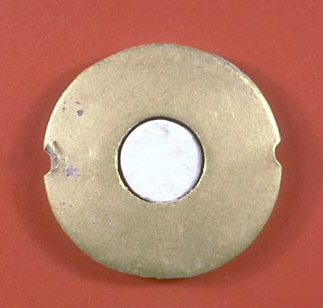
The gold disc.
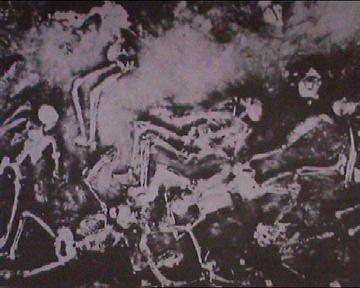
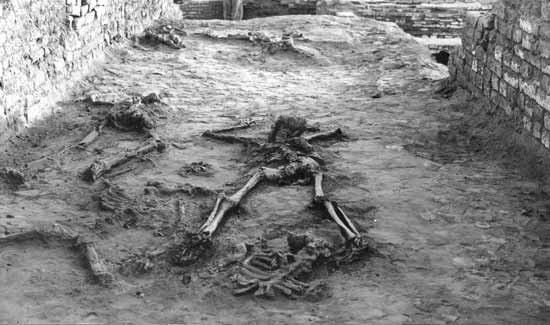
The last levels of occupation show skeletons with sword-cuts (12), holding hands and lying in the streets as though recording a tragic end to the city.
Authorities look away as plunder of Mohenjodaro continues
Article: By Dilshad Azeem. Tuesday, February 24, 2009
ISLAMABAD: Authorities appear to be dragging their feet in preventing the pilferage of precious artefacts from the Mohenjodaro site, according to an official document. A revised master plan for conservation and promotion of cultural tourism at the Mohenjodaro site awaits the federal government’s nod at a time when President Asif Zardari and PPP senior vice-chairman and Prime Minister Yousuf Raza Gilani are at the helm of affairs. But the Mohenjodaro site, falling under the federal government’s jurisdiction, is regrettably facing a double whammy: non-stop pillage of antiques and severe seepage and damage, reveals the document made available to The News. Major features of the revised master plan are archaeological conservation, acquisition of land, further excavation and conservation, landscaping and environment development, a tourism monument plan and an interpretation system. |
El ministro hindú de Ciencia y tecnología ha anunciado el descubrimiento de los restos arqueológicos de la que, hasta ahora, parece ser la primera ciudad conocida de la historia de la Humanidad. Los restos, con una dimensión de más de 10 km, se encuentran sumergidos en las aguas del Golfo de Cambay, la ciudad estaba situada a las orillas de un rio, y se data alrededor del 7500 antes de C., es decir, muy anterior al año 3000 a. C de algunas ciudades sumerias de Mesopotamia, que hasta ahora se consideraban las más antiguas.
En el año 2000 el Instituto Nacional de Tecnología Marina de la India encontró, en el Golfo de Khambhat, a 40 metros de profundidad, estructuras megalíticas similares a una ciudad.
En 2001 el ministro de Ciencia y Tecnología Murli Manohar Joshi, afirmo que las estructuras sumergidas encontradas en el golfo de Khambat (Cambay), son los restos de una ciudad antigua que fue destruida por inundaciones imprevistas. y además, se dijo que las ruinas mostraban un fuerte parecido con las de Harappa y Mohenjo-Daro.La arqueología tradicional remonta estas antiguas civilizaciones hindúes a la cultura neolítica llamada Mehrgarh (10.000 a.C.).
Tambien en el 2001 se encontraron fragmentos de leña carbonizada cerca a la ciudad sumergida, que fueron datados con el método del carbón en 16.950 años.
Se han recuperado docenas de artefactos y objetos de madera y cerámica. Algunos de esos artefactos, se remontan a una antigüedad de 32.000 años, pero según los oceanógrafos, la zona quedó cubierta hace 9.000 años. Los hallazgos fueron enviados a algunos laboratorios hindúes y europeos (Oxford y Hanover). y a través del método de la termoluminiscencia, obtuvieron dataciones de 13.000 a 32.000 años atrás. Las reliquias fueron analizadas con la técnica de difracción de los rayos X. Los resultados evidenciaban que el material arcilloso utilizado era típico de la zona y fue cocido a 700º para obtener la cerámica. Así que la ciudad sumergida del Golfo de Khambat, se remontaría a 10.000 años atrás. Así que los datos científicos coinciden, y no se contradicen. Una ciudad de miles de años de antigüedad, fue inundada en la época que la Atlántida lo hizo.
Al noroeste del Golfo de Khambhat, se encuentra la ciudad de Dwarka, donde se han encontrados restos de un asentamiento que acabó inundado por el mar. A 20 metros de profundidad, se han encontrado calles adoquinadas, paredes de arenisca y restos de lo que fue un puerto. Los antiguos textos hindúes, hablan que la antigua ciudad de Dwarka, era el lugar de residencia de Khrishna, una deidad hindú. En el texto épico Mahabharata, Dwarka era una inmensa y rica ciudad construida sobre una isla por el dios Krishna. Debido a una maldición que pesaba sobre Krishná y su familia (los iadus), la isla se hundió en el mar.
mas alla de la ciencia:

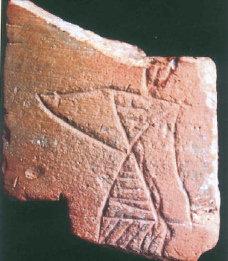



No comments:
Post a Comment